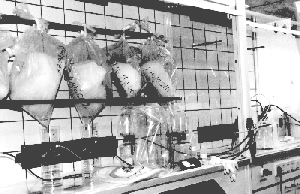Snow
Rationale
By sampling the snowpack at the end of winter (Fig. 1), one obtains
an integrated estimate of winter deposition, both in terms of
dissolved and particulate matter (wet and dry deposition, respectively).
Long-transported pollutants and locally derived dust alike are
trapped in the snow cover.
Advantages
Cheap and rapid medium to sample and analyse.
Yields deposition data representing a long time period in cold,
temperate regions.
Dissolved and particulate contributions can be separated (Fig.
2).
Drawbacks
Redistribution of the snow by wind during or after snowfall.
Snowpack melt dynamics may wash out particular elements preferentially.
SNOW SAMPLE COLLECTION
![[cd2-14]](/Kola/cd2-14_.gif)
(Photo: C. Reimann)
Fig. 1: Samples of snow are collected by inserting a clean, transparent
polyethylene tube vertically almost down to the ground surface. The
thickness of snow cover is recorded.
|
MELTING AND FILTRATION OF SNOW

(Photo: H. Niskavaara)
Fig. 2: After collection in the field, snow samples are kept frozen until
arrival in the lab. There, they are allowed to thaw, and are filtered with
the on-line system shown. Filtrate and filter residue are analysed separately.
|



![[cd2-14]](/Kola/cd2-14_.gif)



